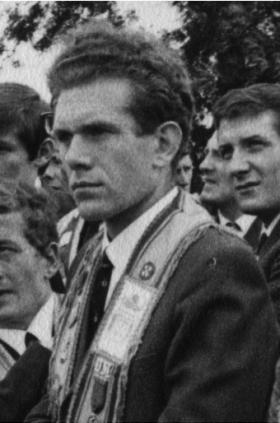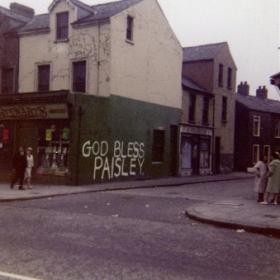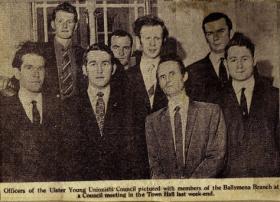Protestant fears & Civil Rights: self-fulfilling conspiracies?
Published in 20th-century / Contemporary History, Features, Issue 5 (Sep/Oct 2008), Northern Ireland 1920 - present, Volume 16
Roy Garland at 1969’s ‘Twelfth’ at Belfast’s ‘field’ at Finahy. (Belfast Telegraph)
In the early 1960s I began to attend Ian Paisley’s Free Presbyterian Church, which seemed obsessed with ‘Romanism’ and Romish conspiracies. It was claimed that the Catholic Church wanted an Ireland Romanised from end to end as a springboard from which to take possession of England. The Irish state elevated the Catholic Church to a special position, incorporated Catholic theology in its constitution, denied rights to divorce and contraception, and brought poverty and want to much of Ireland. If that church gained power in Northern Ireland we believed we would lose everything. Northern Ireland was the basis of our security, our faith and our freedom. Catholicism in our view tended towards tyranny, whereas Protestantism fostered freedom and democracy. Because of these perceptions, any threat to Northern Ireland’s existence would meet determined resistance. Hence my forebears, including my socialist grandfather, signed the Ulster Covenant and probably participated in the 1914 gun-running.
Despite this, my father regarded party politics as a ‘dirty game’. He voted for independent unionists and devoted his spare time to the local church and to a holiness group based in Anderson, Indiana, which accepted women in the ministry, had mixed (black and white) congregations and pastors, and believed in ‘the unity of all true Christians’. They welcomed Pastor Martin Luther King’s contribution to civil rights, but in Belfast the church had no standing whatever and was dismissed by a local Anglican vicar as ‘not a church . . . only a hut’. At school I feared being mocked by teachers if I admitted to being a member of the Church of God, so I claimed to be Presbyterian as I attended a Presbyterian Sunday School.
After a religious conversion in 1955 at the Belfast Jack Schuler Crusade I was invited, with others, to commit my life to Christ. Schuler told us we could face persecution and warned that the Red Army could be marching through the streets of Belfast. One film in the church depicted Christians being massacred by communists in far-off places. A lesser-known visiting Methodist preacher, William McGrath, spoke about Ireland: land of a dying faith. He claimed that Protestantism was dying in Ireland and even in Ulster. Protestants now only formed a majority within a 30-mile radius of Belfast and the streets would soon flow with blood.
Yet Belfast streets were relatively quiet, with Catholic/Protestant relations generally good. Some Shankill Road Protestants and Falls Road Catholics frequented each other’s public houses, and the IRA border campaign didn’t affect our lives. An astonishing claim was also made by Preacher McGrath, however: that the IRA had gone communist and had become a major threat directed by Moscow. This message was preached in churches and halls throughout Ulster. Prayers and evangelism were needed to stem the Red tide, but in Orange Halls the emphasis was on taking up the gun to defend Ulster.
The Divis Street riots of 1964 lent support to these dire predictions. The catalyst was the reaction of Ian Paisley and others to an Irish tricolour displayed in the window of the Sinn Féin offices of local republican Billy McMillen. Paisley threatened a march on Divis Street and the ensuing riots were taken as evidence of his perceptiveness and that of the Percy Street preacher. By 1966 plans were captured in Dublin suggesting a new IRA social, political and military offensive. Civil agitation would heighten tensions and prepare the ground for revolution. The plans were real but greatly exaggerated, with the IRA allegedly infiltrating unionist organisations like the Orange Order and contemplating a 1916-style rebellion in Belfast.

‘God bless Paisley’—graffiti that appeared in Beresford Street, off the Shankill Road, in early 1969 after Paisley had been jailed for his part in an illegal counter-demonstration in Armagh at the end of 1968.
This was uppermost in our minds as republicans planned their 50th anniversary celebration of Easter 1916 with a parade through Belfast. A counter-demonstration organised by Noel Docherty on behalf of Ian Paisley took place that same day and passed within sight of the republican demonstration. The Stormont, British and Irish authorities were concerned about possible violence, and travel from the Republic was restricted. In the event only minor trouble occurred at the end of the Paisley parade after an Irish tricolour was flaunted in Denmark Street. Paisley tried in vain to stop the rioting using a loud hailer.
Communist Party member Betty Sinclair led the republican parade alongside Gerry Fitt. Although Betty Sinclair was by all accounts a moderating influence, her presence led to consternation because it suggested communist backing for the parade. She had been trained in Moscow and these events took place at the height of the Cold War. During the following year, 1967, Pastor Richard Wurmbrand of Romania published his Tortured for Christ, an account of his experiences during imprisonment by the communist regime. Graphic details of his torture were included. The book was widely read, and Wurmbrand addressed a large evangelical audience in Belfast’s Wellington Hall and spoke about the subversive activities of Soviet communists.
By 1968 the left-wing nature of the threat seemed to be confirmed by a strange coincidence. While working in a store in Aberdeen Street on the Shankill Road I noticed a newspaper blowing in the wind. It settled at my feet and turned out to be a republican newspaper, The United Irishman. My eyes fell on a report of a speech at Bodenstown by Seán Garland, who advocated republican involvement in social and economic issues. He added that ‘No longer will the Army of the Irish Revolution stand idly by’, suggesting an attempt to overthrow Northern Ireland using social agitation as a lever to destabilise it. We believed that we faced aggression from without—as reflected in the Republic’s constitutional claim to Northern Ireland territory—and subversion from within. Armageddon stared us in the face.
The Northern Ireland Civil Rights Association (NICRA) was launched in 1967 and was soon categorised as an IRA/communist front. To this day some unionists have not questioned this interpretation. A steering group was created for NICRA with two members representing the Communist Party and two the leftist Wolfe Tone Society. Billy McMillen of Republican Clubs, who had adopted the new approach, was also elected. Significantly, Robin Cole, former chair of Queen’s University Young Unionists, was co-opted and later elected onto the executive, but this was not widely known at the time.

Roy Garland (left) at an officers’ meeting of the Ulster Young Unionists in Ballymena in 1970. Also in the picture (back row, right) is John (now Lord) Laird and, to his right, current leader of the Ulster Unionist Party (now Sir) Reg Empey. (Ballymena Guardian)
William Craig, the Stormont minister of home affairs, claimed that the civil rights movement had been infiltrated by subversives. He was privately challenged by RUC Inspector General Albert Kennedy, who rejected official attempts to project NICRA as an IRA front. Other RUC officers took a different view. Ian Paisley tended to emphasise the threat posed by Romanism and ‘traitorous’ ecumenical Protestants. A former leading UVF brigadier, Billy Mitchell, heavily influenced by Ian Paisley, told me that he saw the civil rights movement as a Catholic thing and an IRA front. He observed the January 1969 People’s Democracy march from a bridge at Antrim town and was astounded at these affluent students apparently demanding rights for Catholics when he and his friends got nowhere near a university and lived in rickety huts without any modern conveniences.
For right-wing unionists the presence of republicans, communists and other radicals in NICRA was a godsend. I knew that some Young Unionists were supporters or members of NICRA but they were seen as suspect. One of them, a Catholic, even decades later, declined to talk, apparently fearing some kind of continuing threat. Two Protestant friends, who initially saw NICRA as a liberating movement similar to that in the USA, became disillusioned. One was later literally bombed out of the nationalist area where he was born, while the other left NICRA after hearing extreme nationalist rhetoric. He joined the RUC and became a victim of IRA terrorism. By April 1970, as an active Young Unionist and Orangeman with support from Bill Craig, I gave my analysis of the situation to hundreds of delegates at the Ulster Unionist Party annual conference in Belfast’s Ulster Hall. I said that the civil rights movement was an IRA ploy:
‘The old IRA policy of straightforward physical violence is largely dead. As the movement moved towards the far left it was realised that the bomb and bullet policies of the past had failed. It had alienated a great amount of support. This support had to be regained and a bridge built between the people and the military wing of the IRA. The connecting link was to be found in movements involved directly with the people in civil agitation. The IRA thus has become the unseen hand directing the activities of civil rights and revolutionary front movements. The IRA has become a much more potent revolutionary force which should never be underestimated.’
The final phase would be a violent one from which the IRA thought they would emerge successful or be annihilated. Under pressure from Westminster the Northern Ireland government had agreed to a series of reforms, and I claimed that they had become a ‘puppet of the socialist administration in Westminster’. I demanded that they resist pressure and demonstrate that they were masters in their own house:
‘Our government must no longer tolerate interference from Westminster in matters clearly within the jurisdiction of Northern Ireland, nor must they tolerate any semblance of government by a minority or from the streets’.
The following year at Stormont, Ian Paisley said that the Unionist government was clearly not ‘master in its own house’.
Many unionists, however, knew that change was needed; O’Neill initially had overwhelming support, but suspicions increased. An older, reactionary, right wing was strengthened by Young Unionists new to politics who took many of their ideas from Ian Paisley’s rallies. On the other hand, NICRA itself was undermined by a violent campaign initiated by the Provisionals. Loyalists assumed that doomsday was at hand and began organising to counter Provisional violence and Irish imperialism. We still struggle with the legacy of the Provisional onslaught. While some unionist friends actively opposed NICRA parades, I rejected direct opposition because that would confirm the absence of such rights and play into IRA hands. People’s Democracy engaged in coat-trailing, but the vicious attack on their marchers at Burntollet was a nail in the unionist coffin.
The crucial element in long-term change was NICRA’s challenge to unionists within the state. This did more to undermine the old regime than bombs and bullets. I revised my own thinking, as did leading loyalists who, like the Official IRA before them, developed ‘new thinking’. Gusty Spence (Ulster Volunteer Force) said that the Unionist regime was not as unblemished as unionists thought but neither was it as corrupt as nationalists claimed. Contacts with Official Republicans were established and some mutual understanding grew but was hampered by continuing violence. Like the Official IRA before them, loyalists were castigated as communists but something of their ‘new thinking’ survived into the 1990s, when a new loyalism seeking mutual accommodation emerged and made a significant impact on the Peace Process.
Roy Garland is an Irish News journalist.
















